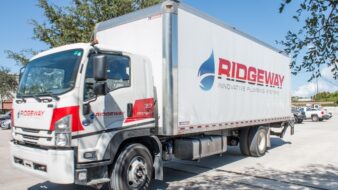Fire Department of New York Marine Company 9, one of three marine departments in NY, built a new firehouse barracks to provide a home pier for their new vessel. At 140 feet long, The Firefighter II is the country’s biggest fireboat. Like the new ship, the 8,000 square-foot firehouse is on the cutting edge of design and sustainability.

Located along Staten Island’s northern shore, facility’s design focuses on sustainability, durability and affordable maintenance. A ‘green’ roof, two solar arrays, and a tight building envelope reduce the carbon footprint. The solar equipment shares roof space with a variety of local, sun loving vegetation.

The larger of the two arrays is a solar thermal system, comprised of nine evacuated-tube panels. The array – which provides domestic hot water and space heat – covers 450 square-feet of the roof. It’s capable of producing nearly 400 MBH, although New York weather makes actual heat output subject to wild variation.
The other array is a 4.5 kW photovoltaic system, and is tasked with providing power for system controls and circulators.
BTU distribution
“Right now we have around 40 employees, and our focus is mainly on commercial and industrial HVAC work in the tri-state area,” said Roman Liberstein, director of operations at Midtown HVAC Enterprises.
When installation of the solar thermal array was complete, Midtown ran the glycol lines into a 475-gallon tank produced by Niles Steel Tank. The heavily insulated tank has four separate coils inside.

“The first coil is for glycol from the solar-thermal array,” said Liberstein. “It keeps the tank at its target temp of 180°. The second coil supplies space heat, and the third and fourth coils provide heat to the two hybrid water heaters.”
All tanks produced by Niles Steel Tank (NST), whether carbon steel or stainless, have a topcoat insulation option. The sprayed-on, rigid insulation has an R-value of 7.2 per inch. Thicknesses of up to four inches are available. The insulation then receives a double layer of acrylic coating.
“Multi-coil tanks allow system designers to dedicate an array of collectors to a specific coil within the tank,” said Mark Betterly, national sales manager for NST. “Depending on the end-use of the water, the possibilities are nearly endless.”
“Large volume, multi-coil solar tanks eliminate the need to string a lot of smaller tanks together,” continued Betterly. “This reduces piping costs and the overall footprint in the mechanical room. In industries that require frequent tank re-charges, multiple coils make a lot of sense.”
At the firehouse, once the four coils were hooked up and the tank was filled, it was permanently sealed. Not only does the tank act as a thermal buffer, but as a massive, four-way heat exchanger as well.
Domestic water
“Two of the coils in the big Niles tank are dedicated to supplying DHW, using heat exchangers as pre-heaters for the standing electric water heaters,” said Demetrios Velentzas, plumbing foreman at Olympic Plumbing & Heating Services in Cambria Heights. Two, 80-gallon solar/electric hybrid water heaters handle the kitchen, four showers, and outdoor hot water needs at the fire station.
“There are times when the solar thermal array meets all the needs for the domestic water system,” continued Velentzas. “When it isn’t sunny, or the space heating component of the system is placing a large demand on the tank, the solar-heated coil inside the water heaters isn’t enough. That’s when the electric element in the hybrid tanks turn on to meet the demand.”
The PV array is accompanied by four, 14-volt batteries. “Together the batteries can supply 60 amps,” said Anthony Santoro, general foreman for Staten Island-based Unisys Electric. “The PV panel supplies power to the controls, circulators for the fan coil units, and circulator for the solar-thermal array.”
Space heat
For space heat, a heat exchanger transfers energy to four hydronic coils within the building’s duct system. Hydro-air units between 20,000 BTU and 130 MBH are used in various areas. Rooftop heat pumps supply extra heat if the solar array can’t keep up.
“If the array produces more energy than the building can use, BTUs are literally tossed to the wind. A large heat dissipater on the roof is used as the dump load,” said Mark Keptsi, at WCA Engineers. “At 91° air temperature, the fin-tube coil is designed to reject as much heat as the array can produce.” If the system is nearing overheat conditions, 300° glycol is pumped directly from the solar panels through the dissipater.
FDNY Marine Company 9 now has a new facility to call home. Getting the Firefighter II into service is faster than ever, with the new location and facilities.





Join the conversation: